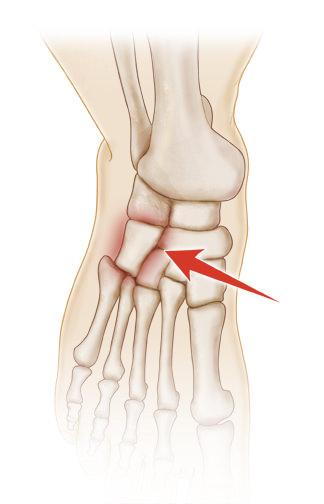Cuboid syndrome, also called cuboid subluxation, is a common type of foot injury, particularly in athletes. Even though it is common, it is often misdiagnosed and subsequently treated improperly.
Cuboid syndrome occurs when there is an injury or dislocation on the lateral side of the foot, the outer side with the small toe. The injury is in the area of a small tarsal bone in the foot, the cuboid bone. The cuboid bone is located roughly at the midpoint of the outer side of the foot, and together with the other tarsal bones, it forms the arch of the foot. Other structures that may be involved in the injury include the calcaneocuboid joint and the surrounding ligaments.
 What Causes Cuboid Syndrome?
What Causes Cuboid Syndrome?
Typically it is athletes who develop cuboid syndrome, either after an injury, or as lateral foot pain that appears without a noticeable injury. Athletes presenting with cuboid syndrome are often runners or ballet dancers, and one study showed that as many as 80 percent of cuboid syndrome patients also have flat feet.
Cuboid syndrome is often associated with repetitive movement of the foot, such that which occurs during running or dancing. The muscle that is believed to be associated with cuboid syndrome is the peroneus longus muscle, a muscle located on the outside of the lower leg and is responsible for stabilizing the midfoot. Continual or repetitive movement of this muscle may result in a malalignment of the cuboid bone.
Another possible cause of cuboid syndrome is an injury, such as a sprained ankle. An ankle sprain in which the foot turns inward (called an inversion ankle sprain) may damage the ligaments connected to the cuboid bone. This type of ankle injury can happen to almost any athlete, but is common with basketball, football, and soccer players.
Signs and Symptoms of Cuboid Syndrome
- Pain, particularly in the lateral midfoot, especially when walking.
- Redness and/or swelling.
- If the cuboid syndrome is associated with an ankle injury, there may also be pain, swelling, redness, and restricted movement in the ankle.
Diagnosing Cuboid Syndrome
During a physical exam, the following findings point to a diagnosis of cuboid syndrome:
Pain: The lateral midfoot is tender, and palpating the area may be painful. There may also be redness in the area (erythema) and slight swelling. Patients may also experience pain when hopping on the affected foot, or may even be unable to hop.
Decrease in motion: Patients with cuboid syndrome may find inversion ankle movement to be painful, and may resist or avoid these movements.
Uneven gait: Patients with cuboid syndrome may exhibit an antalgic gait — i.e., they seek to avoid putting weight on the affected foot. Pain during walking may occur as the foot pushes off the floor.
There is no one specific test that can be conducted to accurately diagnose cuboid syndrome, but there are maneuvers that may aid in diagnosis.
Midtarsal adduction test: While stabilizing the ankle joint with the right hand, the left hand is used to hold the foot around the midpoint. The foot is then moved inward, in the direction of the other foot. This movement compresses the patient’s calcaneocuboid joint and may cause the symptoms of cuboid syndrome.
Midtarsal supination test: In this test, the ankle joint are again stabilized while the foot is manipulated in roughly a half-circle (this is also called triplane motion). This motion will also cause the pain of cuboid syndrome.
Treatment of Cuboid Syndrome
Treatment of cuboid syndrome involves manipulation of the cuboid. In cases in which cuboid syndrome was secondary to an ankle injury, treatment may be postponed until the ankle has healed sufficiently. If there is redness, swelling, or a hematoma present on the foot, those conditions should be adequately resolved before manipulation of the cuboid is attempted.
After manipulating the cuboid bone, further management of the patient consists of massage, cryotherapy (ice), non-thermal ultrasound and/or electrical stimulation. In some cases, manipulation may need to repeated.
Further Treatment and Prevention for Cuboid Syndrome
Other treatments may be used to prevent the injury from recurring or to provide relief from any lingering symptoms after manipulation.
Padding and taping: Supporting the cuboid bone with padding or a wedge may help prevent recurrence. Taping may also be used to support and stabilize the bones of the midfoot.
Exercise: Exercises that can help with symptoms and prevent the injury from occurring again.
Orthotics: Because many people who develop cuboid syndrome also overpronate, orthotics may be useful in preventing recurrence. Orthotics are worn inside the shoe to promote the proper alignment of the foot.
If you or someone you know is experiencing this condition please given one of our offices a call for a consultation. We are here to help!